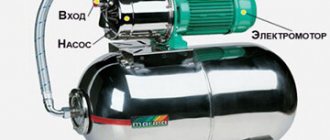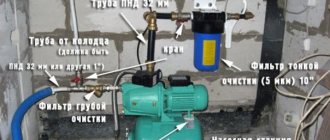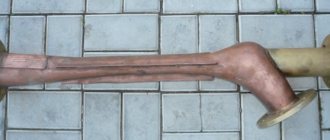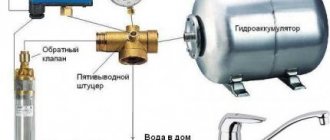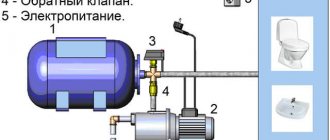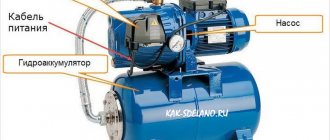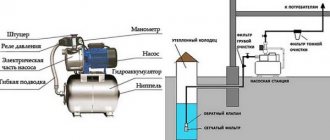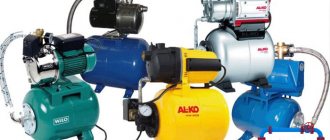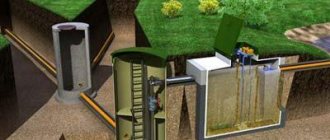Almost all owners of country houses and dachas are familiar with the water station, because it is what allows them to be independent from the centralized water supply. But not everyone knows what to do if the unit has stopped performing its direct functions - it does not build up pressure and does not turn off in time. That is why, in order to reduce the discomfort from a station breakdown, we will talk about the most common causes of the indicated malfunctions and figure out how to properly eliminate them on our own. Next, we bring to your attention not only the theoretical basis, but also a useful video of the repair work being carried out.
How does pressure affect the operation of the station?
Why are pressure indicators generally important for the functioning of a water station?
In order to understand this issue, let’s get acquainted with the structure and operating principles of the unit. The main component of the station is the pump, thanks to which water is pumped. Its engine has one serious drawback - every time the pump is turned on, it experiences an overload. As a result, when the station is started frequently, the engine quickly becomes completely unusable. To prevent such a negative phenomenon, it is necessary to reduce the number of pump starts - for this, the station is equipped with a practical hydraulic accumulator in which water accumulates.
Construction of a water station
The pressure to fill the tank with water is created by the force of air. However, this operating scheme does not make it possible to use level sensors, so the switching on and off processes are regulated by the pressure in the water supply. For this purpose, the equipment is equipped with another important device - a pressure switch. As a result, the system functions in this way: as soon as the volume of water in the accumulator drops to a critical value, the pressure drops to a minimum level and the relay turns on the pump, and when the tank is completely filled, the pressure rises to a maximum and the relay turns off the pump.
But sometimes it happens that the pump turns on very often and does not turn off. The reason for this phenomenon is low pressure in the system. Most often, a water station cannot gain the pressure it needs for the following reasons:
- drop in pump power;
- insufficient voltage in the electrical network;
- leaks in the water supply;
- pump airing;
- accumulator problems.
We propose to consider each of these reasons in more detail.
Frequent breakdowns of the water station
In most cases, the answer is simple - the liquid level in the source has decreased. Then the intake does not reach it, and the equipment runs idle. The danger is that when operating in this mode, pumping stations quickly fail.
When the pump does not pump water from the well, the cause may be a clogged coarse filter. Silt, sand, clay and debris clog the mesh and prevent normal fluid intake into the hose. In this case, it needs to be cleaned and rinsed under running water. But if the pumping station does not pump water, this may not be the reason. Therefore, you need to pay attention to how the units operate.
The pump turns, but does not pump water
This manifestation may indicate that:
- Mechanical components are worn out. A submersible pump does not pump if the blades are broken, the wheel is disconnected from the shaft, or there is wear on the walls of the working chamber. In addition, the pumping station is humming, but there is no liquid in the pipes when the bearings crumble and debris jams the wheel.
- The water intake has become disconnected. Depressurization results in air being pumped into the hose instead of liquid. This can happen if the clamp has rotted or the flexible tube has become unusable due to mechanical stress. In any case, the consequences of this failure can be seen without disassembling the pump.
There are other reasons, but they are much less common. Malfunctions of internal components suggest that the pump is de-energized, disconnected and will have to be disassembled. Worn parts must be replaced immediately.
The unit works without stopping
If a working well pump does not pump water when all connections and pipes are in order, then the reason may lie in the incorrect operation of additional equipment or the system as a whole. If there is insufficient electric current in the network, then there is simply not enough power to lift the liquid from underground to the surface.
In this case, there is no pressure in the pipeline, and the relay does not turn off. The danger is that the unit overheats and may fail completely. The solution is to measure the voltage, and if the situation in the region is considered normal, you need to include a step-up stabilizer in the system. When wondering why the pump does not pump water from the well, the voltage is checked first, and the equipment is immediately de-energized.
Low pump power
Before purchasing a water station, the required pump power must be calculated taking into account the depth of the well, the volume of water used and the design features of the water supply system. But even this cannot protect against the fact that one day the power of the unit will begin to decrease.
Connecting a water station
Insufficient power of the pumping unit may be due to the following reasons:
- Wear of structural parts. Most often, the cause of the problem is imbalance of parts: grains of sand and small contaminants accumulate between the pump shafts, which loosen the elements of the unit and prevent it from working at full capacity. The simplest solution to the problem is to install purification filters at the water inlet. The second possible reason is deformation of the rubber valve. In this case, it is recommended to completely replace the part, since even after repair the valve will not allow the pump to develop the required power.
- Decrease in water level in the well. The most rational, albeit costly, way to solve the problem is to purchase a deep-well pump.
Advice. When buying a pump, choose a model with a power reserve in case, during the operation of the water station, you need to lay additional pipes or install new household appliances that use water.
Finding the reason
To troubleshoot a water pump, it is important to first find out the cause of the failure. But first of all, it is necessary to determine those conditions without which normal operation of the device is impossible:
- The amount of water that the pump will lift to the top. Reducing its level can affect the pressure.
- Electrical power parameters must correspond to the technical characteristics of the pump. In other words, you need to correctly select the power of the device in accordance with the depth of the well and the calculated water flow.
- Pump serviceability.
- Taps, filters, valves, pipes and other elements of the device must also be in good working order. Failure of at least one component of the system will lead to malfunctions.
Often, tap water in a private home is needed not only for domestic consumption, but also outdoors (for watering the garden, washing the car). Therefore, the cause of the malfunction should be sought in three directions - in the hydraulic system, indoors and outdoors. How to determine the cause? Let's use the elimination method.
First, disconnect the supply hose located in the caisson. If water flows out, it means there is a problem either indoors or in the pipes outside.
If there is no liquid, then the reason may be hidden in the well itself or pump parts. Sometimes this situation happens - the device hums, but there is no water. Then the most likely reasons are:
- Incorrect installation or some parts of the pump that are not quite suitable.
- A decrease in water in the well, as well as surges in the electrical network, can also cause problems with water supply.
- Phase loss during operation of the electric motor.
Insufficient mains voltage
Power outages are absolutely not uncommon in rural areas. Unstable voltage in the network has a negative impact on all devices powered by electricity, and water stations are no exception: due to insufficient voltage, the unit cannot fill the accumulator tank full, and then build up the required pressure and turn off.
The optimal solution to the power supply problem is to purchase an uninterruptible power supply and a voltage stabilizer: the first will provide the required level of power supply, and the second will protect the water station pump from sudden surges in voltage levels.
Advice. Before purchasing a pump and auxiliary equipment - a UPS and a stabilizer - it is recommended to measure the voltage in the network for 2-3 days using a multimeter to understand which devices are needed specifically in your case.
General information. Causes of pumping station problems
The elements that are included in the pumping station form a common system. These include:
1. expansion tank to store water.
2. pump device.
3.bypass membrane, which prevents water from draining.
4.pressure regulation relay, with its help the control of starting and stopping power equipment is carried out.
5.device for connecting to electricity.
Experts identify the main causes of problems:
1.water decreases in the system to a critical level.
2. The filter becomes clogged at the inlet.
3. violation of the tightness of the system.
4. ejector failure.
5. breakdown of elements of the pump device.
6. problems with the relay device, or restriction of free access to the device input.
Leaks in the plumbing system
If the water station does not turn off, it means there is not enough water in it, that is, there is a leak somewhere in the water supply system.
Most often, metal pipes leak - they are affected by corrosion processes that provoke the appearance of holes. A temporary solution to the problem is to wrap the cracks with special plumbing tape. But, of course, as soon as the first opportunity arises, the deformed section of pipe should be replaced.
Leaks can also occur in the areas of threaded pipe connections and twisting of parts. In these cases, it is necessary to close the leaking areas with a sealing sealant: paste, fum tape or rubber rings.
Plastic pipes rarely leak - if this happens, it is only due to damage from freezing. To solve the problem, you should wrap the pipe in the leakage area with plumbing tape and additionally cover it with heat-insulating material.
Most equipment problems can be fixed by yourself.
Air in the pump or air leaks
The water level may also drop in the pumping station itself. In this case, the liquid is simply leaking in one of the critical places. Of course, it is difficult not to notice a puddle near a leaking faucet, but water can escape from the system in other areas.
Important! With the pump constantly running, check the pipeline for leaks.
To avoid disruptions in the operation of the pumping station, it is necessary to eliminate all leaks
Here you need to be especially careful. After examining the connection points of the pipes near the pumping station, move on to other places. Cracks found in pipes are carefully sealed with special tape. This is only a temporary repair; the damaged area will need to be replaced in the future.
If a leak appears on the threaded connections, it is necessary to turn off the pump and add tow to the threads, and if necessary, replace the rubber ring or gasket. This is especially true when using low-quality pipes, when the diameter of the rubber sealing ring is slightly larger than the diameter of the pipe. In some cases, water may leak from a crack in the flange adjacent to the accumulator. Then the part is removed, the hole is welded and installed back.
Note! It is recommended to seal threaded connections using a special thread called Tangit Unilok. Even a beginner can use this sealant, because a slight overdose of thread will not lead to destruction of the part when screwed onto the thread.
The cause of the leak may also be a check valve, which is installed on the supply pipeline. This device will not retain liquid through accumulated dirt. In this situation, the pumping station pumps water to the lower pressure level and turns on again. Constant operation of the pumping station is often observed at night, when no one was using the taps or shower.
Important! A pump that runs continuously can quickly fail.
Pump airing
The water station stops gaining pressure and performing its functions if air gets into the working chamber or pump line. This phenomenon is not uncommon, especially if a surface pump is used: when the water in the well drops below the permissible level or the suction hose is deformed, air inevitably enters the pumping system.
To squeeze out the air, you need to connect a special tee to the pump and release water under pressure. And subsequent actions will depend on the cause of the airing.
If the problem is in the well, you just need to lower the hose slightly below the original level or equip the pump with a float switch. If airing occurs due to deformation of the hose, you need to find all the cracks and close them with plumber's tape. In case of large holes, it is recommended to completely replace the hose.
How the device works
The automation unit is designed to supply voltage to the water supply device when the pressure in the system drops below the set limit. The switched on pump supplies water to the water supply system and at the same time to the hydraulic accumulator. When you open a tap or other water supply device, water begins to flow to the consumer under the action of the accumulator membrane. Until the pressure drops to the set value, the automation contacts will be open.
A drop in pressure triggers the automation, the contact group of which closes, supplying power to the pump.
Accumulator problems
Problems with the hydraulic accumulator of a water station can occur when:
- the pressure in the relay is set incorrectly - you need to slightly loosen the nut of the small spring, and then the unit will be able to gain the pressure it needs and turn off without delay;
Important! If loosening the nut does not help, then the relay itself is faulty and needs to be replaced with a new one.
- the rubber membrane is deformed - if water starts to drip when you press the air fitting, it means that the membrane has ruptured and should be replaced;
- there is no pressure in the tank - use a special air pump to pump air into the hydraulic accumulator chamber;
- the check valve is leaking - if the pump starts to leak when the station is not in use, it means the check valve is clogged and needs to be cleaned.
So, here are the most common reasons why a water station stops gaining pressure and turns off in a timely manner. By understanding the nature of faults and how to eliminate them, you can not only protect yourself from discomfort due to unit breakdowns, but also free you from the need to call specialists to solve the problems mentioned above.
Reasons for lack of pressure and how to fix them yourself
There is no single answer to the question why the pumping station does not gain pressure, and there is also no panacea to solve this problem.
It all depends on the reason for the failure. It is not difficult to identify it and repair the pumping station if you consistently “walk” along the entire path of the liquid and examine the equipment responsible for its circulation.
The water level has dropped
If there is not enough inflow in the well and well, then the pump pumps idle.
This cannot last long, and the electrical elements will eventually burn out. Those models that are equipped with protection will be disabled, which is also a reason to think that this is the problem. We will have to wait until the well is filled again, but in the meantime we need to use alternative sources.
The inlet filter is clogged
In this case, the pumping station does not turn off, but is operational. The only thing you need to do is clean the mesh from sand and clay. If the bottom of the well is silted, you will have to clean it. In any case, you need to remove the pump and make sure that this is the problem. Models with a built-in filtration system require periodic maintenance, which consists of washing the filter.
Air in the pump or air leaks
Deep pumps must be completely submerged in water.
If it peeks out, then it is not surprising that air is pumped into the system along with water. Check that the pump is lowered to the correct depth. And if the pumping station is located on the surface, then most likely there is a hole in the hose coming from the source through which air is sucked in. The depth of lowering the pump will also have to be double-checked so that it does not run dry.
Ejector or gasket problems
Low pressure may be due to a faulty ejector. This unit is equipped with some modifications of pumps to increase productivity and improve performance indicators. Its task is to increase the energy of fluid transmission through the pipeline by throwing in an additional system. But if the ejector water intake is clogged, it must be cleaned manually.
Impeller wear
The blades that swirl the flow in a centrifugal suction system must fit tightly to the glass, but at the same time the free rotation of the wheel, which rotates with the help of bearings, is ensured. Failure of at least one of them leads to jamming. And if it leaks through the gap between the blades and the body, the suction capacity will decrease. You will have to disassemble the pump and replace worn parts.
The relay fitting is clogged
Automatic shutdown is performed by opening the electrical circuit. This is possible using a special pressure switch. The assessment of operating parameters is carried out through automated measurement of parameters. If debris gets into the inlet fitting, the pressure switch will not operate when needed. The result is that the pump does not turn off. The solution is to clean the inlet hole of the pressure switch fitting.
Low voltage
Not all pumping stations are equipped with protection against voltage surges in the network.
The problem is that when there is a shortage of energy, it is turned on, but there is not enough power to maintain the required pressure. This means that the well pump can work, but its performance is not enough to squeeze water to the surface. It will not turn off unless equipped with a special electronic protection system.
The solution is to test the electrical network to determine whether it has sufficient voltage. To eliminate this problem forever, you need to connect a stabilizer to the circuit, which will protect the equipment installed in the house from surges and short circuits. Protective electronics only save the electrical part of the equipment from burning out. The stabilizer eliminates this possibility in principle.
Leakage in the system
If the pipes leading from the pump to the point of consumption have a break, it is the same as turning on a faucet and leaving it open. The pressure is distributed and is no longer sufficient for normal functioning of the consumer. To identify a leak, you need to go through the entire circuit, observing the wetness, and also checking all points at the time of closing. The repair consists of shutting off the ball valve and repairing the hole in the pipeline.
Weak pump power
This is not a breakdown, but rather the negligence of the homeowner when selecting equipment. There is no way to fix the problem; you will have to buy a new pumping station. The calculation takes into account the compliance of the passport capacity and the required flow rate of all consumers. This must be taken into account when organizing irrigation and to ensure water supply to a residential building.
For well pumps, the main indicators, in addition to productivity, are the height of the water column and the distance over which the equipment can transmit liquid in the horizontal plane. When calculating the water column, it is generally accepted that a pressure of 1 bar is enough to raise water to a height of 10 meters. But there must be a pressure of at least 1.5-3.5 bar in the pipeline.
Air got into the pipe
An air lock is the consequence of an incorrectly installed pipeline. A cavity may form in elbows, bends and other places that water pressure cannot push through. It is not difficult to determine in which area this happened, because before the airy area the pressure is too high, and after it there is none at all. The solution is to turn off the water supply, dismantle the system and reassemble it in a different configuration. If there is a problem and nothing is done, the situation will become regular. The consequence is pump failure.
Problems with the accumulator
If the system is equipped with a storage tank and there is water in it, but it does not flow from the tap, then the outlet valve is most likely clogged.
If a hydraulic tank is installed in the chain, but the lack of pressure may be due to insufficient air pressure in the bulb. You will have to disconnect the tank and measure it using a pressure gauge.
Devices with a diaphragm are dismountable, and a leaky unit can be replaced. The bulb can also be changed, but if you have to act in this way, then after finishing the work you need to pump exactly enough air into the air chamber so that the pressure is the same as indicated in the technical data sheet for the accumulator. It is taken into account that at the time of sale it contained not oxygen, but an inert gas.
